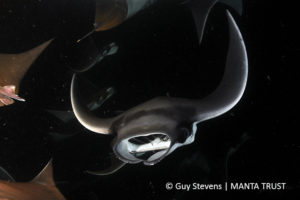New Regulations will be in force from the 4th April 2017!
The highly threatened devil ray has received a new level of protection at a recent international meeting on wildlife trade.
PTES grantee Jane Hosegood updated us on this latest good news after attending the Convention on the International Trade in Endangered Species (CITES) meeting in Johannesburg. She is an expert in ray genetics and current leads a PTES funded study with the aim of developing genetic tools for their conservation.
Protecting the devil rays!
“Both the devil rays, and their sister group, the Manta rays, are fished in huge numbers to supply the international demand for their gill plates, which are used as a pseudo-remedy in some traditional medicines, despite no evidence that they provide any real health benefit. This trade is unsustainable, as these species have a very slow reproductive rate, and so are unable to recover from exploitation. Sadly, as a result, major declines have been reported in many populations around the world.
 But some good news has recently come out of a large international meeting on wildlife trade. All 9 species of devil ray, are to join their close relatives, the Manta rays, on Appendix II of the Convention on the International Trade in Endangered Species (CITES), following the success of a proposal submitted by the government of Fiji. 183 countries are signatories to CITES, and will now be required to regulate and monitor trade in gill plates, or any other parts or derivatives of these species. Similar protection was also agreed for silky and thresher sharks.
But some good news has recently come out of a large international meeting on wildlife trade. All 9 species of devil ray, are to join their close relatives, the Manta rays, on Appendix II of the Convention on the International Trade in Endangered Species (CITES), following the success of a proposal submitted by the government of Fiji. 183 countries are signatories to CITES, and will now be required to regulate and monitor trade in gill plates, or any other parts or derivatives of these species. Similar protection was also agreed for silky and thresher sharks.
I was lucky enough to attend the recent CITES meeting in Johannesburg alongside colleagues from The Manta Trust and TRACE Wildlife Forensics Network, and so saw first-hand how events unfolded. Despite some discussions of concerns regarding enforcement of the proposed listings, the devil ray proposal was a success, receiving the required two-thirds majority vote from government delegations from the signatory countries. This listing will come into effect later this year.
It was really great to see 4000 people, mostly government officials, from all over the world coming together to discuss issues of trade in wildlife products, from elephants to pangolins, parrots to sharks, and of course, the ‘mini mantas’ or devil rays.
The fact that the devil rays are now to be regulated under CITES is excellent news. It is not just beneficial for the devils – but Mantas too. Mantas were listed in 2013, and so trade in Manta parts has been regulated for the last few years. However, due to difficulties identifying between gill plates of different species, specialist training was required to distinguish between listed manta parts, and unregulated devil ray parts. In light of the recent resolutions for the devil rays, all gill plates are now regulated, and so it is no longer possible to hide manta gill plates among devil ray gill plates in trade. Not only that, but the new listings allow for more stringent and standardised monitoring of the trade, and is therefore a massive step forward for marine conservation.
 My work focuses on developing genetic tools for the conservation of Manta and devil rays, and so this new listing is very relevant for me. The conference was a fantastic opportunity for me to talk to people from around the world about how my science could be used to help with problems faced when implementing regulations such as CITES. One of the main problems surrounding manta and devil rays on CITES is identifying which species a gill plate came from. It’s very clear that high up on the wish list of those on the frontline against the illegal wildlife trade is some sort of tool to help them quickly, easily and cheaply identify a wildlife product to species level. Fortunately, this is exactly what I’ve been working towards for Manta and devil rays for the last couple of years, with the help of generous support from PTES.
My work focuses on developing genetic tools for the conservation of Manta and devil rays, and so this new listing is very relevant for me. The conference was a fantastic opportunity for me to talk to people from around the world about how my science could be used to help with problems faced when implementing regulations such as CITES. One of the main problems surrounding manta and devil rays on CITES is identifying which species a gill plate came from. It’s very clear that high up on the wish list of those on the frontline against the illegal wildlife trade is some sort of tool to help them quickly, easily and cheaply identify a wildlife product to species level. Fortunately, this is exactly what I’ve been working towards for Manta and devil rays for the last couple of years, with the help of generous support from PTES.
Essentially what we are doing is taking tissue samples from individuals of known species and sequencing short fragments of the DNA that they contain. This allows us to build up a picture of the genetic signatures of each species and population, to which we can compare samples from an unknown individual or part. This could therefore be used to figure out which species an illegal gill plate came from, and allow us to collect data on which species and regions are most targeted for this purpose. I am currently spending my time analysing the genetic data I’ve been sequencing from devil ray species, as well as Mantas.
It was absolutely incredible to be in the room witnessing such an important decision to regulate trade in devil ray parts, and this has spurred me to work even harder to protect these species, and to celebrate the conservation successes!”
